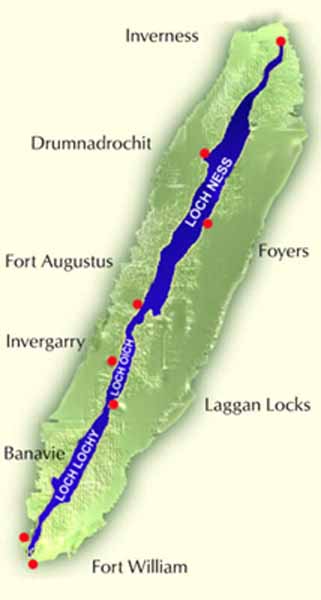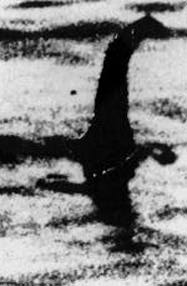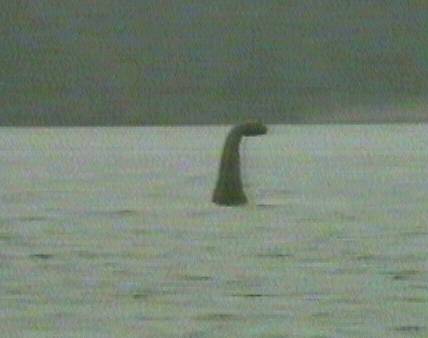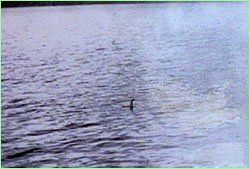The Loch Ness Monster, affectionately known as Nessie by the locals, is said to live in the large Loch Ness Lake in Scotland. Loch Ness Lake is 22 miles long, about a mile wide, and at it's deepest point it is 950 feet deep. In a nearly inaccessible, remote area up until the early 1930's, Loch Ness Lake is part of the Great Glen which runs like a deep crack clear across Scotland. A small town, Fort Augustus is located at the southern end of the lake, and the town of Inverness is located at the northern end of the lake.


Nessie has been seen in the Lake for a very long time, it seems. Sightings of Nessie have been reported in print as early as AD 565 in the manuscript of Life of St. Columba (vol. 6, book 11, chap 27). It seems that a water monster had bitten to death a man in the Loch Ness Lake.
Nessie was first spotted in a modern report in the 20th century in July of 1930. Three young men were fishing in a boat out on the lake, close to Dores in the southern part of the lake. Suddenly, 600 yards the water became disturbed as a large creature just under the surface of the water was swimming toward them. It turned away about 300 yards from their boat.
The most famous photo, supposedly taken of the creature happened on April 1, 1934 by a surgeon, about 2 miles north of Invermoriston. He was planning to take pictures of birds, but was in for a surprise when first arriving at this spot, so the story goes. He saw the customary disturbance in the water that is always reported when Nessie makes an appearance. Using a telephoto lens, he managed to get a clear head shot of the "serpentine head," a dinosaur-like neck and its tiny head before it slipped into the lake once more.

At this time, the scientific community declared it a fake, nothing more than an April fool joke. Many years later, another Nessie investigator, Tim Dinsdale made a startling discovery. If one looks closely at the entire picture frame, one can see from a distance the faint "concentric circle" of rings around the head of the creature, and if you look closely, you can see another circle in the background to the creature, indicating that a body is just below the surface. In 1972, this photo was enhanced by a NASA computer, and whiskers were seen hanging down from its mouth. However, in March 1994, it was revealed that the "surgeon's picture" was a practical joke after all by his son, Ian. Using a toy submarine and a fake head, a picture of Nessie was taken, creating the mother of all most successful practical jokes!
The most successful mission to photograph the real Nessie was the 1975 expedition, sponsored by the Academy of Applied Science, in cooperation with the Loch Ness Phenomena Investigation Bureau. One camera with high speed film activated by sonar was placed on a bottom ledge, 80 ft down in the lake. Another camera, taking pictures on a preset interval, hung 40 feet down from the boat, and 40 ft up from the bottom camera, as a back-up system for a 24 hour period; from June 19th to June 20th.
While sonar repeatedly showed large objects near the bottom camera, something had stirred up the silt on the bottom of the Loch, blacking out all the pictures. The camera that was forty feet above this bottom camera, using a took some amazing pictures in the area of the strobe light beam. Pictures of a portion of a pinkish body, an upper torso, neck and head of a living animal, with two stubby appendages are seen. The most startling picture is a clear image of an underwater dragon looking at the camera, in half profile, showing its nostrils, an open mouth and several horn-like projections . After studying several frames of its various body segments, it is suggested that this curious animal has an overall length of 20 feet, with an 18 inch neck, a 9 inch long, 5 inch wide mouth and 6 inch long horns, about 10 inches apart.
Other clear pictures of the animal were taken by Dr. Robert H. Rines, who led a team of investigators from The Academy of Applied Science at the Mass. Institute of Technology, in 1972 and 1975. One of his 1972 pictures shows very clearly an 8 foot long, flipper-like object. A 1975 photograph of his clearly shows a long-necked creature and its front flipper.

Some of the scientific community, as represented by Roy Mackal, a director of the Loch Ness Investigation Bureau and a professor of Biochemistry at the University of Chicago concludes that "a population of moderate-sized, piscivorous aquatic animals is inhabiting Loch Ness." In his 1976 book, "The Monsters of Loch Ness," he thoroughly examines all of the evidence of this unknown species of animal with a critical eye, and still comes to this conclusion. Despite this 1976 book, many in the scientific community are still doubtful about the animals' existence, which has been the traditional view, despite credible evidence.
There are several theories as to what kind of animal / creature, this Nessie may be in reality. One theory claims that pictures of Nessie are identical to a plesiosaur of the Mesozoic era, that was supposed to be extinct for more than 70 million years. Specifically, some scientists think Nessie is an Elasmosaur, a member of the Plesiosaur family. The original theory of monster hunter, Ted Holiday, who spent time from 1962 - 1965 investigating Loch Ness lake, concluded in his book, The Great Orm of Loch Ness, that the creature was simply a giant version of the common garden slug, an ancestor of the squid and octopus. A type of "Tullimonstrum gregarium, a creature with a shape of a submarine, with a broad tail." Holiday argued that these creatures were in ages past all over England, and were the basis for the dragon legends.

0 comments:
Post a Comment